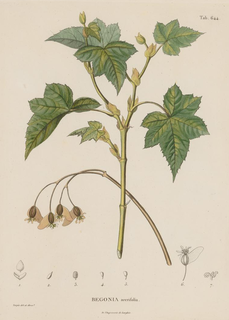Mannophryne lamarcai is a species of frog in the family Aromobatidae. It is endemic to Venezuela and inhabits a narrow altitudinal band in the Ziruma mountains between the states of Zulia, Falcón and Lara. Its natural habitats are subtropical or tropical moist montane forest and rivers. It is threatened by habitat loss.

Arends' golden mole is a species of mammal in the family Chrysochloridae. It is found in Mozambique and Zimbabwe. Its natural habitats are temperate forests, subtropical or tropical dry forest, subtropical or tropical moist montane forest, temperate grassland, subtropical or tropical dry lowland grassland, arable land, pastureland, plantations, rural gardens, urban areas, and introduced vegetation. It is threatened by habitat loss.

Begonia acerifolia is a species of plant in the family Begoniaceae. It is native to Ecuador, Peru and Bolivia. Its natural habitats are subtropical or tropical moist montane forests and subtropical or tropical dry shrubland. It is threatened by habitat loss.
Begonia adpressa is a species of plant in the family Begoniaceae. It is endemic to Cameroon. Its natural habitats are subtropical or tropical moist lowland forests and subtropical or tropical moist montane forests. It is threatened by habitat loss.
Begonia asympeltata is a species of plant in the family Begoniaceae. It is endemic to Ecuador. Its natural habitat is subtropical or tropical moist lowland forests. It is threatened by habitat loss.
Begonia dodsonii is a species of plant in the family Begoniaceae. It is endemic to Ecuador. Its natural habitats are subtropical or tropical moist lowland forests and subtropical or tropical moist montane forests. It is threatened by habitat loss.
Begonia duncan-thomasii is a species of plant in the family Begoniaceae. It is endemic to Cameroon. Its natural habitats are subtropical or tropical moist montane forests and rocky areas. It is threatened by habitat loss.
Begonia furfuracea is a species of plant in the family Begoniaceae. It is found in Cameroon and Equatorial Guinea. Its natural habitat is subtropical or tropical moist lowland forests. It is threatened by habitat loss.
Begonia hitchcockii is a species of plant in the family Begoniaceae. It is endemic to Ecuador. Its natural habitat is subtropical or tropical moist montane forests. It is threatened by habitat loss.

Begonia oxyanthera is a species of plant in the family Begoniaceae. It is found in Cameroon, Equatorial Guinea, and possibly Nigeria. Its natural habitats are subtropical or tropical moist lowland forests and subtropical or tropical moist montane forests. It is threatened by habitat loss.
Begonia pelargoniiflora is a species of plant in the family Begoniaceae. It is found in Cameroon and Equatorial Guinea. Its natural habitat is subtropical or tropical moist lowland forests. It is threatened by habitat loss.
Begonia pseudoviola is a species of plant in the family Begoniaceae. It is found in Cameroon and Nigeria. Its natural habitat is subtropical or tropical moist lowland forests. It is threatened by habitat loss.
Begonia schaeferi is a species of plant in the family Begoniaceae. It is found in Cameroon and Nigeria. Its natural habitats are subtropical or tropical moist montane forests and rocky areas. It is threatened by habitat loss.
Begonia secunda is a species of plant in the family Begoniaceae. It is endemic to Ecuador. Its natural habitat is subtropical or tropical moist montane forests. It is threatened by habitat loss.
Begonia tropaeolifolia is a species of plant in the family Begoniaceae. It is endemic to Ecuador. Its natural habitat is subtropical or tropical moist montane forests. It is threatened by habitat loss.
Begonia xerophyta is a species of plant in the family Begoniaceae. It is endemic to Ecuador. Its natural habitat is subtropical or tropical moist montane forests. It is threatened by habitat loss.
Begonia eiromischa, commonly known as woolly-stalked begonia, is a presumed extinct plant from Malaysia.
Hendrik (Henk) Cornelis Dirk de Wit was a Dutch systematic botanist who contributed significantly to the knowledge of the Aroid genera Cryptocoryne and Lagenandra. He grew up in the Waterland, a marshy area in the Northwest Netherlands, and had a lifelong interest in aquatic plants.

The World's 25 Most Endangered Primates is a list of highly endangered primate species selected and published by the International Union for Conservation of Nature (IUCN) Species Survival Commission (SSC) Primate Specialist Group (PSG), the International Primatological Society (IPS), Global Wildlife Conservation (GWC), and Bristol Zoological Society (BZS). The IUCN/SSC PSG worked with Conservation International (CI) to start the list in 2000, but in 2002, during the 19th Congress of the International Primatological Society, primatologists reviewed and debated the list, resulting in the 2002–2004 revision and the endorsement of the IPS. The publication was a joint project between the three conservation organizations until the 2012–2014 list when BZS was added as a publisher. The 2018–2020 list was the first time Conservation International was not among the publishers, replaced instead by GWC. The list has been revised every two years following the biannual Congress of the IPS. Starting with the 2004–2006 report, the title changed to "Primates in Peril: The World's 25 Most Endangered Primates". That same year, the list began to provide information about each species, including their conservation status and the threats they face in the wild. The species text is written in collaboration with experts from the field, with 60 people contributing to the 2006–2008 report and 85 people contributing to the 2008–2010 report. The 2004–2006 and 2006–2008 reports were published in the IUCN/SSC PSG journal Primate Conservation,, since then they have been published as independent publications.




